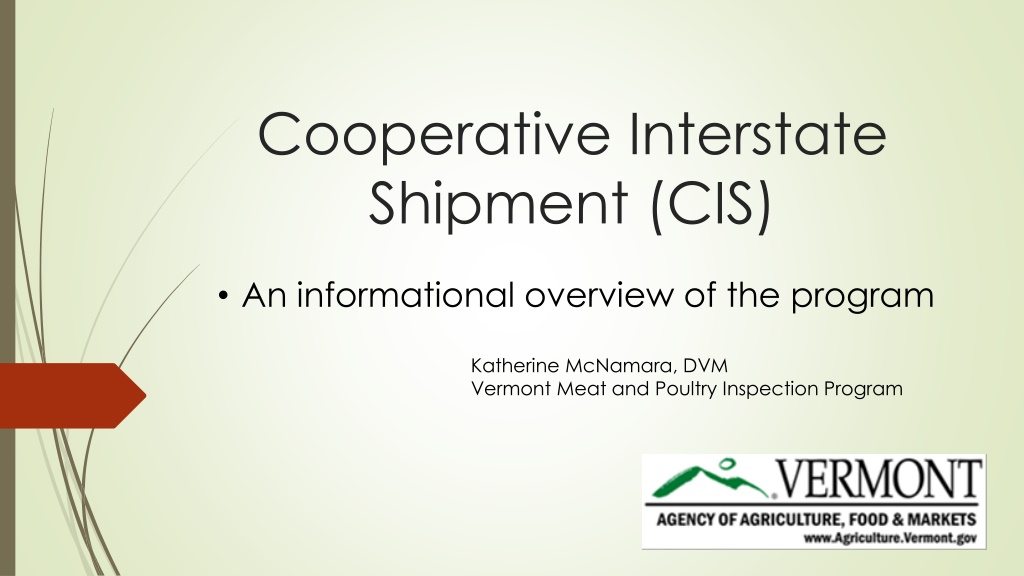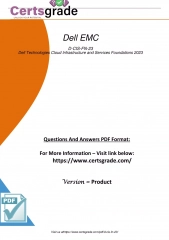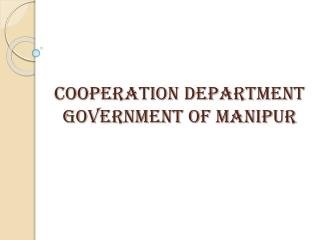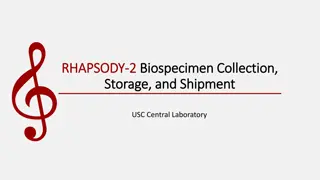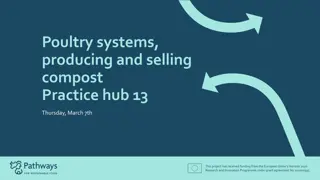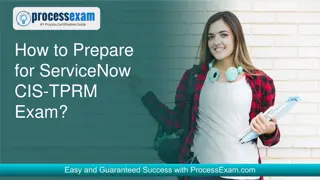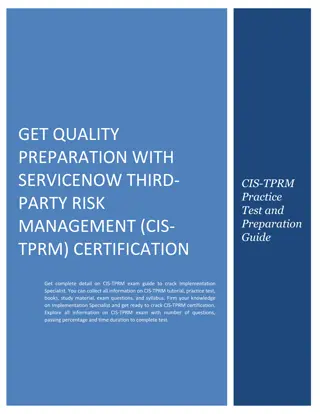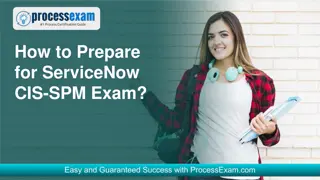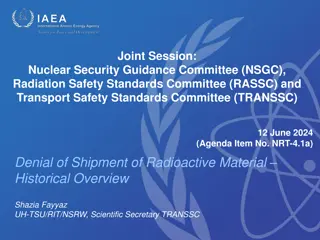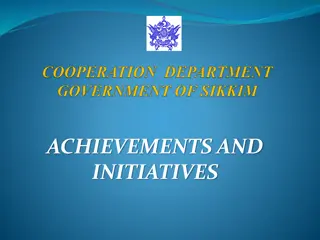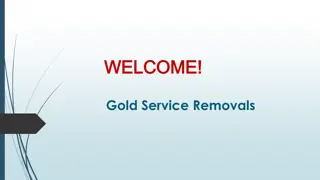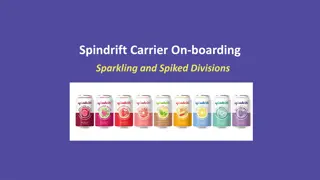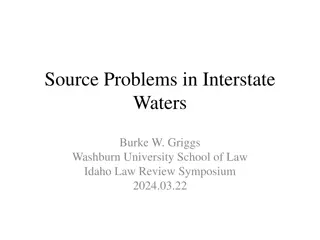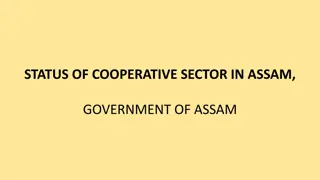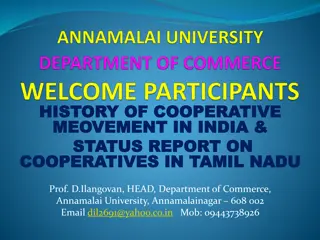Cooperative Interstate Shipment (CIS) Overview
The Cooperative Interstate Shipment (CIS) program allows selected state-inspected establishments to ship their products in interstate commerce. Created by the 2008 Farm Bill, it enables small and very small state-inspected establishments to participate, with specific application requirements and non-starter criteria. Vermont joined the program in 2020, emphasizing the importance of meeting general application requirements to qualify for CIS participation.
Uploaded on Mar 05, 2025 | 0 Views
Download Presentation

Please find below an Image/Link to download the presentation.
The content on the website is provided AS IS for your information and personal use only. It may not be sold, licensed, or shared on other websites without obtaining consent from the author.If you encounter any issues during the download, it is possible that the publisher has removed the file from their server.
You are allowed to download the files provided on this website for personal or commercial use, subject to the condition that they are used lawfully. All files are the property of their respective owners.
The content on the website is provided AS IS for your information and personal use only. It may not be sold, licensed, or shared on other websites without obtaining consent from the author.
E N D
Presentation Transcript
Cooperative Interstate Shipment (CIS) An informational overview of the program Katherine McNamara, DVM Vermont Meat and Poultry Inspection Program
What is CIS? The CIS program allows selected state-inspected establishments to ship their product in interstate commerce Joining the CIS program is completely voluntary. State inspection staff continue to perform the daily inspection tasks Federal reviewer ( Select Establishment Coordinator or designee) visits quarterly to semi-annually The mark of inspection is a round inspection mark with the establishment number and the letters SEVT to indicate select establishment
Background This program was created by the 2008 Farm Bill Federal Meat Inspection Act and Poultry Products Inspection Act amended to establish a cooperative inspection program under which certain small and very small State-inspected establishments will be eligible to ship meat and poultry products in interstate commerce Only states that have an established Meat and Poultry Inspection Program (MPI) can participate On August 11, 2020, the Vermont Agency of Agriculture, Food and Markets (VAAFM) signed a cooperative agreement with the United States Department of Agriculture, Food Safety, and Inspection Service (USDA-FSIS) to join the Cooperative Interstate Shipment (CIS) program.
General Application Requirements The establishment has processed inspected products under the VAAFM MIP for at least 90 days The establishment has had a satisfactory Food Safety Assessment (FSA) within the last 12 months, and is in good standing with the VAAFM MIP The establishment has no more than 25 employees on average that will handle any CIS product The establishment has adequate measures to completely separate CIS- inspected product from any other products and activities within the establishment
Non-Starters Establishments are not eligible if they: Are currently a federal establishment Have been a federal establishment/been shipping interstate as of June 18, 2008 (date of CIS enactment) Have had more than 25 employees as of June 18, 2008
General Application Process Refer to VT Directive 5740.2, the Cooperative Interstate Shipment Program Shipment Application Process Notify Meat Inspection Chief of desire to participate Apply in writing using the form MPI-5740.2 Application for Cooperative Interstate Shipment (CIS) program. Work with your in-plant Food Safety Specialist to submit a new MI-5 label approval forms for CIS, showing the CIS mark of inspection All currently-approved, official products are eligible You may choose to produce all, or only some products for CIS
Form MI-5740.2CIS application
State Review Process Upon receipt of the application, the MPI Section Chief will schedule an initial onsite visit of the establishment Schedule an FSA if one has not been performed in the last 12 months During the onsite visit, MPI staff will perform: (a) Review of the establishment flowchart(s), Hazard Analysis (HA) and HACCP plan(s), including all pre-requisite and SSOP programs; (b) Review of the establishment recall plan; (c) Review of the establishment food defense plan; (d) Review of generically approved labels; (e) Walkthrough of establishment facilities; and (f) Observation of each process that the establishment would like to perform under the CIS program Recommend for selection when all criteria are met (and we re confident your establishment will pass the federal review)
Federal Review Process Selected Establishment Coordinator (SEC) or designee conducts an initial and (if necessary) a follow-up visit of each recommended establishment Visit includes: Entrance and exit meetings and completion of required documents Review of employee numbers to verify avg. is 25 or fewer Review of example CIS labels Review of grounds, facilities and equipment Review of SSOPs, HACCP plans, recall plan, and Listeria program (if applicable) Product utilized at processing establishments must be federally-inspected or from other approved CIS selected establishments in the state Purpose of initial visit: does the establishment meet basic requirements? The following forms are completed in the Review:
FSIS FORM 9020-3 Survey Report Survey Check list FSIS FORM 9020.2 Included as Attachment 3 to FSIS Directive 5740.1
Federal Follow-up Review If Federal standards are not met on the initial visit, the SEC will discuss these with the establishment and State personnel Establishment completes any necessary actions to resolve the concerns State program notifies the District Office when establishment is has completed the necessary actions and is ready for a follow-up visit Follow-up visit and survey is completed to verify all Federal standards were met Establishments that meet all necessary Federal standards and requirements are recommended for selection An establishment that does not pass on the second, follow-up survey may not reapply for one year
Things to Consider (have ready) for Federal Review Information for FSIS Form 9020-2: establishment name, address, and telephone number; establishment operator and title; and nature of operations, hours of operations, types of species slaughtered, types of processing operations, and distribution information Information for Survey Checklist (refer to the check list): I. Required Documents Written SSOPs, HACCP plan, Water potability cert, Sewage cert, inedible removal, Written recall plan (not listed but REQUIRED): see How to Develop a Meat and Poultry Recall Plan BSE-SRM written program for SRM removal if you slaughter cattle II. Marks of Inspection Labels - example CIS lables ready for reviewer Brands Brand authorization provided after successful review Security for accountable items Provide Inspection office a lockbox of brands and important documents
Things to Consider (have ready) for Federal Review - continued III. Building Construction Basic facility requirements for sound construction of buildings, structures, rooms Written procedures for complete physical separation of official selected establishment operations and nonofficial selected establishment operations by time or space (i.e. state inspection, custom or retail) Plumbing must meet basic requirements for sufficient clean water for processing, good drainage, sewage disposal, no backflow IV. Safety Written Lock-out/Tag-out program, enough emergency exits, no hazards
Things to Consider (have ready) for Federal Review still continued V. Facilities and Equipment Welfare facilities clean, working, hot/cold running water, soap, towels? Outside premises pest control plan or company, no harborage areas, outside opening gaps filled, etc. Antemortem pens, driveways, ramps in good repair, good footing; stunning equipment in good repair, good animal handling practices, adequate space and lighting, suspect pen area Postmortem/Processing adequate room and lighting for inspector, adequate area for holding retained product, condemned/inedible areas or barrels Employee numbers be ready to show W2s, pay records, etc. to prove Can choose to produce product under CIS and state if desired
What Happens After Selection? Ongoing Reviews After the start of operations, the federal Select Establishment Coordinator (SEC) will visit the establishment on a regular basis for follow-up visits Frequency for visits by the SEC is typically quarterly for the first year, and semi-annually thereafter Verify the state is providing inspection in a same as manner as the USDA FSIS Verify the condition of the establishment, records, SSOPs, inspection records (NRs, MOIs, weekly meetings, sample results), humane handling (if applicable), labels, condemned product handling, etc. SEC can submit product samples for analysis SEC has the authority to initiate an enforcement action if they observe violations
Deselection of Establishments from the CIS Program Selected establishments that become ineligible to participate in the CIS program for any reason will be deselected and must transition to become an official Federal establishment Violating the Federal Acts If inspection is suspended for any of the reasons specified in 9 CFR 500.3 or 500.4, you may be deselected (for example, produced and shipped adulterated product, inadequate HACCP plan, grossly insanitary conditions, violated a regulatory control action (tag), assaulted or threatens inspection staff, egregious humane handling violations) Employing more than 25 employees on average, or they employed more than 25 but fewer than 35 employees on Deselected establishments must remain under Federal inspection for one year before transitioning back
References and Must Reads if you are Considering CIS for your establishment FSIS Directive 5740.1: Cooperative Interstate Shipment Program 9 CFR Part 313 Humane Handling of Livestock 9 CFR Part 381 Poultry Products Inspection Regulations 9 CFR part 416 Sanitation 9 CFR Part 417 Hazard Analysis and Critical Control Points 9 CFR Part 500 Rules of Practice
